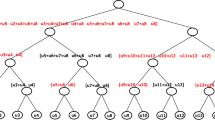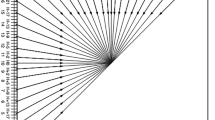Abstract
High-speed video coding and compression are extensively used in many IoT applications with optimum data usage and resolution using three-dimensional discrete cosine transforms (3D-DCT). We propose an efficient hardware implementation for high-speed vector-radix decimation-in-frequency (VR-DIF) 3D-DCT with an optimum area and power consumption. In the previous implementation, the data path arithmetic units used a fixed word length (either 16 or 18 or 21 bits), whereas the proposed architecture uses the range of word length from 11 bits (1-bit sign, 1-bit integer and 9-bit fraction) to 20 bits (1-bit sign, 10-bit integer and 9-bit fraction) to achieve lower silicon area and power consumption. The architecture is optimally pipelined to achieve high processing speed (above 3 Giga samples/s). To test the proposed architecture, an \(8\times 8\times 8\) video cube with a pixel depth of 8 bits is considered. The arithmetic functional units such as signed adder/subtractor and cosine coefficient multipliers required for implementing \(8\times 8\times 8\) 3D-DCT/IDCT processor is designed with the proposed variable word length. The core of VR-DIF 3D-DCT/IDCT with the variable word length is implemented using TSMC 90 nm technology library. The proposed architecture consumes 26.5% and 23.2% lesser area and power, respectively, than the existing fixed word length 3D-DCT-II implementation tested with a maximum frequency of 653 MHz.







Similar content being viewed by others
References
G.P. Abousleman, M.W. Marcellin, B.R. Hunt, Compression of hyperspectral imagery using the 3-D DCT and hybrid DPCM/DCT. IEEE Trans. Geosci. Remote Sens. 33, 26–34 (1995)
N. Ahmed, T. Natarajan, K.R. Rao, Discrete cosine transform. IEEE Trans. Comput. 23, 90–93 (1974)
S. Al-Azawi, O. Nibouche, S. Boussakta, G. Lightbody, New fast and area-efficient pipeline 3-D DCT architectures. Digit. Signal Process. 84, 15–25 (2019)
S. Boussakta, H.O. Alshibami, IEEE fast algorithm for the 3-D DCT-II. IEEE Trans. Signal Process. 52, 992–1001 (2004)
S.C. Chan, K.L. Ho, Direct methods for computing discrete sinusoidal transforms, in Proc. Inst. Elect. Eng. Radar Signal Process., vol. 137, pp. 433–442 (1990)
R.J. Clarke, Relation between the Karhunen Loeve and cosine transforms. IEEE Proc. F Commun. Radar Signal Process. 128, 359–360 (1981)
F. Fang, T. Chen, R. Rutenbar, Lightweight floating point arithmetic: case study of inverse discrete cosine transform. EURASIP J. Signal Process. 9, 879–892 (2002)
E. Feig, E. Linzer, Scaled DCTs on input sizes that are composite. IEEE Trans. Signal Process. 43, 43–50 (1995)
E. Feig, S. Winograd, Fast algorithms for the discrete cosine transform. IEEE Trans. Signal Process. 40, 2174–2193 (1992)
R.C. Gonzalez, P. Wintz, Digital image processing. Inc. Applied Mathematics and Computation, Reading, Mass., Addison-Wesley Publishing Co., vol. 13, p. 451 (1977)
G. Hegde, S. Tripathi, P.R. Vaya, VLSI implementation of the video encoder using an efficient 3-D DCT algorithm. Int. J. Electron. Lett. 4, 38–49 (2016)
H. Hou, A fast recursive algorithm for computing the discrete cosine transform. IEEE Trans. Acoust. Speech Signal Process. 35, 1532–1539 (1985)
IEEE Standard Specifications for the Implementations of \(8\times 8\) Inverse Discrete Cosine Transform, in IEEE Std 1180-1990, pp. 1–12 (1991). https://doi.org/10.1109/IEEESTD.1991.101047
M. Jamunarani, C. Vasanthanayaki, Shape adaptive DCT compression for high quality surveillance using wireless sensor networks. Clust. Comput. 22(2), 3737–3747 (2019)
B.G. Lee, A new algorithm to compute discrete cosine transform. IEEE Trans. Acoust. Speech Signal Process. 32, 1243–1245 (1984)
J. Liang, T.D. Tran, Fast multiplierless approximations of the DCT with the lifting scheme. IEEE Trans. Signal Process. 49, 3032–3044 (2001)
M. Nazir, Z. Jan, M. Sajjad, Facial expression recognition using histogram of oriented gradients based transformed features. Clust. Comput. 21(1), 539–548 (2018)
J.S. Park, T. Ogunfunmi, A new VLSI architecture for 3D-DCT video compression system, in Proc. IEEE SiPS, Taipei City, Taiwan (2013), pp. 135–140
J.S. Park, T. Ogunfunmi, A 3D-DCT video encoder using advanced coding techniques for low power mobile device. J. Vis. Commun. Image Represent. 48, 122–135 (2017)
R. Rădescu, An efficient solution for video compression using an original modified algorithm applied to improve the 3D Discrete Cosine Transform, in Int. Symp. ISFEE, University Politehnica of Bucharest, Romania, pp. 1–5 (2018)
K.R. Rao, P. Yip, Discrete Cosine Transform: Algorithms, Advantages, Applications (Academic Press, New York, 2014)
S. Saponara, Real-time and low-power processing of 3D direct/inverse discrete cosine transform for low-complexity video codec. J. Real Time Image Process. 7, 43–53 (2012)
S. Saponara, L. Fanucci, P. Terreni, Low-power VLSI architectures for 3D discrete cosine transform (DCT). Midwest Symp. Circuits Syst. 3, 1567–1570 (2003)
J. Song, Z. Xiong, X. Liu, Y. Liu, PVH-3DDCT: an algorithm for layered video coding and transmission, in Proc. Fourth Int. Conf./Exh. High Performance Comput. Asia-Pacific Region, vol. 2, pp. 700–703 (2000)
S.-C. Tai, Y. Gi, C.-W. Lin, An adaptive 3-D discrete cosine transform coder for medical image compression. IEEE Trans. Inform. Technol. Biomed. 4, 259–263 (2000)
Video Samples. http://eeweb.poly.edu/~yao/EL6123_s16/SampleVideoData.html
J. Xiuhua, Z. Caiming, Z. Xuefen, An efficient joint implementation of three stages for fast computation of color space conversation in image coding/decoding. Multimed. Tools Appl. 63, 1–15 (2011)
B. Yeo, B. Liu, Volume rendering of DCT-based compressed 3D scalar data. IEEE Trans. Vis. Comput. Graph. 1, 29–43 (1995)
L. Yuanyuan, C. Hexin, Z. Yan, Y. Chuxi, Device-saving pipeline architectures of multi-dimensional DCT similar butterfly algorithm, in Conf. on Integrated Circuits and Microsystems (ICICM) (2016), pp. 339–344
L. Yuanyuan, C. Hexin, Z. Yan, Y. Chuxi, Three dimensional DCT similar butterfly algorithm and its pipeline architectures, in IEEE Information Technology, Networking, Electronic and Automation Control Conf. (2016), pp. 506–510
Y. Zeng, G. Bi, A.R. Leyman, New polynomial transform algorithm for multidimensional DCT. IEEE Trans. Signal Process. 48, 2814–2821 (2000)
Y. Zeng, G. Bi, A.C. Kot, New algorithm for multidimensional type-III DCT. IEEE Trans. Circuits Syst. 47, 1523–1529 (2000)
Y. Zeng, G. Bi, Z. Lin, Combined polynomial transform and radix-q algorithm for multi-dimensional DCT-III. Multidimensional Syst. Signal Process. 13, 79–99 (2002)
Acknowledgements
This research was financially supported by The Research Start-Up Fund Subsidized Project of Shantou University, China, Grant No. NTF17016. The authors would like to thank CH Vijendra Kumar, M.Tech., VLSI design student for assisting in ASIC synthesis trails and Vellore Institute of Technology, Vellore, for providing laboratory facilities.
Author information
Authors and Affiliations
Corresponding author
Additional information
Publisher's Note
Springer Nature remains neutral with regard to jurisdictional claims in published maps and institutional affiliations.
Appendix
Appendix
The optimum word lengths for various stages of the architecture is analysed using the MATLAB model of VR-DIF 3D-DCT and VR-DIF 3D-IDCT and listed in the following Tables 7 and 8.
Rights and permissions
About this article
Cite this article
Arunachalam, V., Joseph Raj, A.N. & Deepika, S. Performance Improvement of Vector-Radix Decimation-in-Frequency 3D-DCT/IDCT Using Variable Word Length. Circuits Syst Signal Process 40, 1818–1831 (2021). https://doi.org/10.1007/s00034-020-01557-w
Received:
Revised:
Accepted:
Published:
Issue Date:
DOI: https://doi.org/10.1007/s00034-020-01557-w




